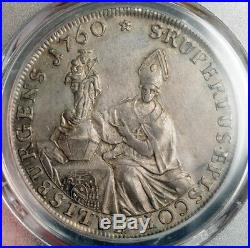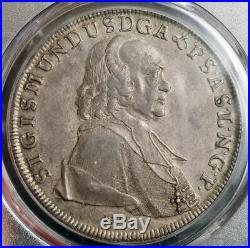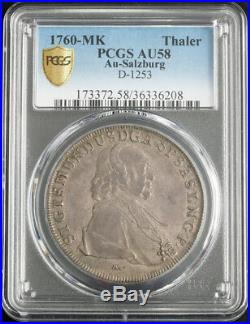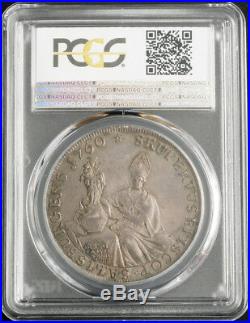1760, Salzburg, Sigismund III v. Schrattenbach. Silver Thaler Coin. PCGS AU-58





1760, Salzburg, Sigismund III v. Mint Year: 1760 Mint Place: Salzburg Denomination: Thaler (Convention) Reference: Davenport 1253, KM-395.1. Certified and graded by PCGS as AU-58! Diameter: 41mm Material: Silver Weight: 28gm. Obverse: Bust of Sigismund III von Schrattenbach as Archibishop-Prince of Salzburg, wearing robe and jewelled cross. Reverse: Seated Saint Rupert, supporting salt barrel topped by the Madonna of Oettingen relic, which is placed on a table. The table is covered with a stiched table-cloth showing the arms of the Archbishop! The Archbishopric of Salzburg was an ecclesiastical state of the Holy Roman Empire, roughly consisting of the present-day state of Salzburg in Austria. The diocese arose from St. Peter's Abbey, founded about 696 by St. Rupert at the former Roman city of Iuvavum (Salzburg).
The last Archbishop with princely authority was Hieronymus von Colloredo, an early patron of Salzburg native Wolfgang Amadeus Mozart. Since 1648, the Archbishop of Salzburg has also borne the title Primas Germaniae ("First [Bishop] of Germania").
The powers of this title now non-jurisdictional are limited to being the Pope's first correspondent in the German-speaking world, but used to include the right to summon the Prince-electors. The Archbishop also has the title of legatus natus ("permanent legate") to the Pope, which, although not a cardinal, gives the Archbishop the privilege of wearing red vesture (which is much deeper than a cardinal's scarlet), even in Rome. The Archbishopric grew to become one of the most important Catholic bastions in Europe. Possibly the most bigoted of all Catholic areas, it expelled the Jews around 1500 and the Protestants in 1731. Sigismund Graf von Schrattenbach (28 February 1698 16 December 1771) was Prince-Archbishop of Salzburg from 1753 to 1771.
He was born in Graz, Styria, the son of Count Otto Heinrich von Schrattenbach and Maria Theresa, Countess of Wildenstein and widowed Baroness Gall von Gallenstein. After studying theology in Rome, Schrattenbach was ordained a priest in 1723 and obtained a seat in the Salzburg cathedral chapter in 1733. In 1747 he was appointed administrator of Hohenwerfen Castle, later also cathedral dean and privy councillor.
He was elected Archbishop of Salzburg after the death of Count Andreas Jakob von Dietrichstein in 1753, after numeorus rounds of voting he finally prevailed against rivalling Joseph Maria von Thun, Bishop of Gurk. During his tenure Leopold Mozart as well as his son Wolfgang Amadeus were appointed members of the episcopal court orchestra. In 1763 he employed Michael Haydn as court composer. Schrattenbach died in Salzburg, aged 73.His funeral service on 2 January 1772 was the occasion for the first performance of the Michael Haydn's Requiem. Schrattenbach was succeeded after his death by Count Hieronymus von Colloredo, the last Salzburg prince-archbishop before the 1803 secularisation. Michael Haydn stayed in Salzburg under the reign of Colloredo; Wolfgang Amadeus Mozart, on the other hand, left soon after.
The item "1760, Salzburg, Sigismund III v. PCGS AU-58" is in sale since Friday, January 18, 2019. This item is in the category "Coins & Paper Money\Coins\ World\Europe\Austria".
The seller is "coinworldtv" and is located in Europe. This item can be shipped worldwide.- Certification: PCGS
- Certification Number: 36336208
- Grade: AU58
- Composition: Silver
- Year: 1760
